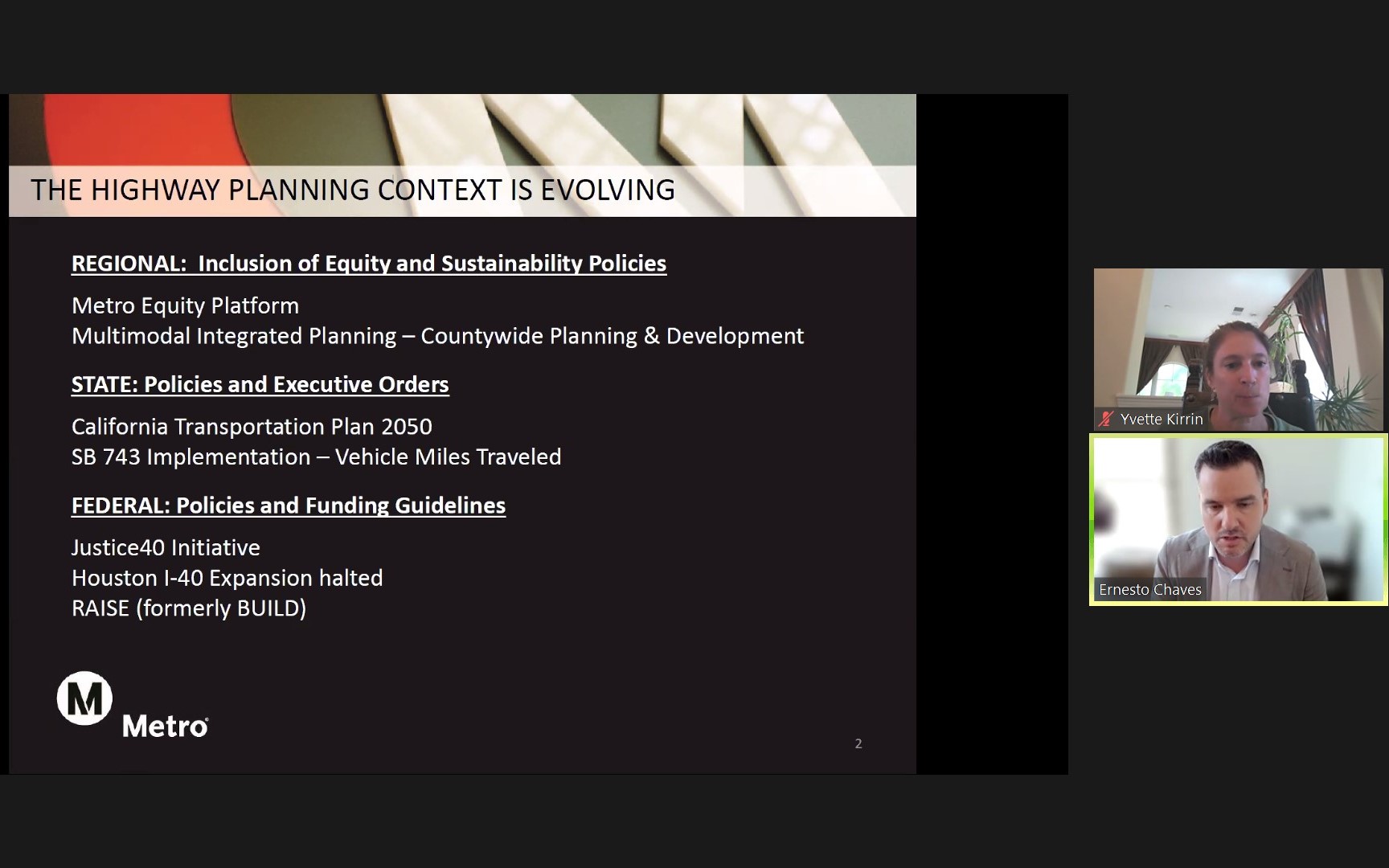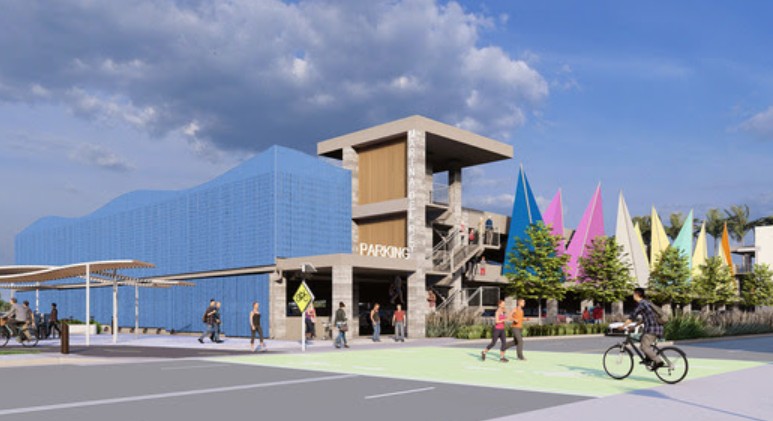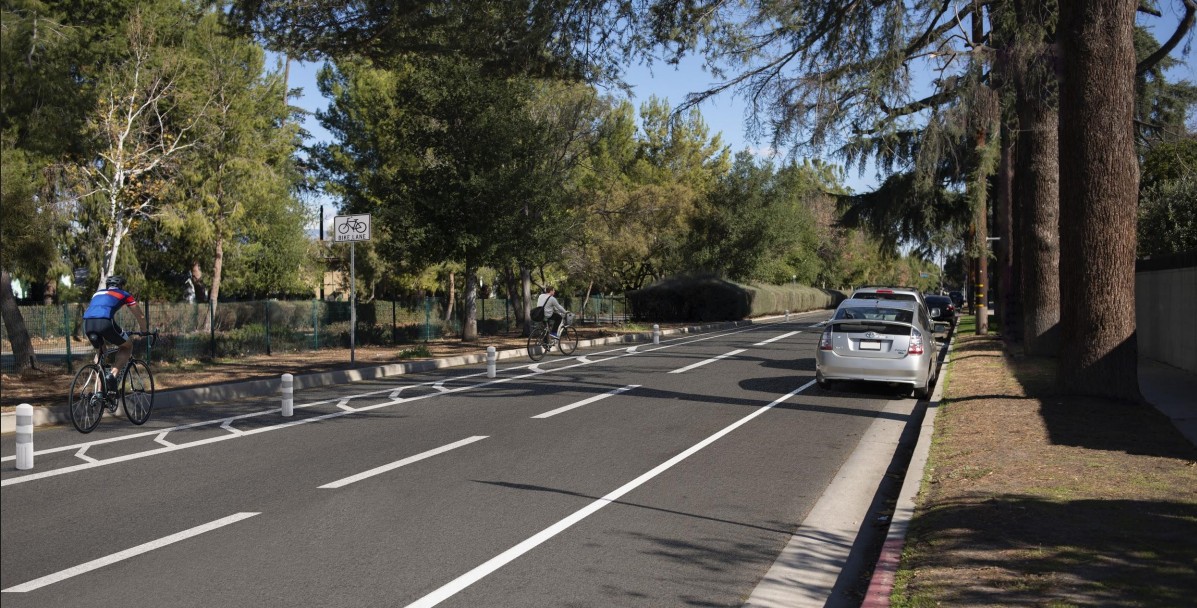Though Metro is backing off from some destructive freeway expansion, suburban interests are signaling they are unwilling to go along quietly with these changes.
Metro is slowly - very slowly - reworking its approach to freeway expansion projects. Though Metro (with Caltrans) is proceeding with a portfolio of billions of dollars worth of freeway expansion projects (widening the 5 in three stretches, the 71, the 57/60, the 91 in three places, the 405, and more), in the last two years, the agency paused two of its most harmful mega-project widenings. In May, Metro responded to community resistance by officially canceling its $6 billion planned widening of the lower 710 Freeway. In late 2020, the Metro board reined in plans for the agency's 605 Freeway Corridor Improvement Project, which was set to demolish more than 300 homes mainly along the 5 Freeway in Downey and Santa Fe Springs.
Metro has been taking internal steps to make its freeway project planning somewhat more holistic.
In the face of internal resistance from Metro Highway Program staff, the board repeatedly approved motions (Highway Program modernization, North 710) to clarify that highway projects can and should include multimodal components. Last year, in order to encourage multimodal projects, the agency's new CEO Stephanie Wiggins moved the Highway Program under the agency's Planning Department.
Last month, the Metro board adopted a new policy [staff report] on Metro Objectives for Multimodal Highway Investment. The one-page objectives include:
- "Support[ing] ... equitable impacts, access to opportunity, regional sustainability, and resiliency for affected local communities and the region."
- "Recognizing L.A. County’s history of inequitable highway investment policies and construction, work with local communities to reduce disparities caused by the existing highway system and develop holistic, positive approaches to maintain and improve the integrity and quality of life of those communities"
- "[highway investment] is considered within the context of a countywide multimodal, integrated planning vision that reflects a holistic approach to meeting the needs of local communities, reducing disparities... [including] fostering greater regional mobility and access to opportunity."
- "Develop[ing] meaningful public engagement processes... that foster engagement with a wide range of stakeholders, specifically people most directly impacted"
Directors Hilda Solis and Jacqueline Dupont-Walker further strengthened the policy, authoring a motion that added "to maintain and improve the integrity and quality of life of [impacted local] communities with minimal or no displacement during the implementation of highway improvements."
At yesterday's meeting of the Gateway Cities Council of Governments (GCCOG) SR 91/605/405 Technical Advisory Committee (605TAC), Metro staff delivered presentations on the new multimodal objectives and on Metro's Equity Platform (adopted in 2018).
Metro's holistic equity-based vision did not receive a warm reception. It felt a bit like two sets of people speaking different languages at each other.
The 605TAC is comprised of southeast L.A. County cities staff responsible for public works, mostly engineers who have spent much of their careers expanding infrastructure to support more and driving. In the past, 605TAC leadership criticized Metro for its Office of Equity and Race having "hijacked" Gateway Cities plans to widen freeways. A similar neighboring TAC was famously openly critical ("tell [Metro] to eff off") when Metro proposed allowing cities the flexibility to include complete streets components in highway projects.
At yesterday's meeting, Metro representatives spoke about equity, buses, resilience, and climate.
TAC members spoke about driving, cars, roads, and freeways.
City of Santa Fe Springs Public Works Director Noe Negrete challenged the recently adopted multimodal objectives, specifically questioning what Metro meant by various terms including: equity, access to opportunity, sustainability, and resiliency.
Negrete asked what Metro means by "access to opportunity." Metro Highway Program Director Ernesto Chaves responded that the phrase refers to Metro increasing communities access to jobs, Negrete responded:
I would say the majority of our citizens' method of travel is by a car. I would say it's probably 98 percent, probably in that range. Their access to opportunity is a roadway, a highway, or a freeway. [...] Overwhelmingly the majority of people are using cars and roads to get there.
(For what it's worth, though Negrete's overall point - the majority of Santa Fe Springs residents travel by car - is true. But his percentage estimate is high. Per the Southern California Association of Government's profile for Santa Fe Springs, as of 2018, 94 percent of Santa Fe Springs commuters traveled by car, including 11 percent carpooling and 83 percent driving alone. Those statistics reflect just commute trips, which tend to show more driving than overall trips. The statistic also does not reflect that higher income residents drive and lower income ones don't. According to the city's proposed Reimagine Santa Fe Springs General Plan Circulation Element, the city's lower income residents have less access to cars, and rely more on public transit. The plan states that "15 percent of renter-occupied units in Santa Fe Springs lacked access to a vehicle, compared to only two percent of owner-occupied households." The proposed plan objectives include transportation equity, defined as "community members who historically have been left out of transportation investments and decisions will be prioritized, engaged, and included.")
Negrete went on to denigrate planned transit extensions to the Gateway Cities: "I would love for L.A. County to be more multimodal" but the Eastside Gold Line and West Santa Ana Branch are "going to take thirty years." (Metro estimates currently show these lines opening an initial phase in 2035 and 2033 respectively.) "Are we just stuck for thirty years with live with the freeway you're on and pray for the multimodal to come sooner?"
Negrete wasn't alone in criticizing Metro. Bill Pagett, City Engineer for the cities of Bell and Paramount, stated "I hate to see that all of a sudden maybe the on-freeway improvements is going to go to multimodal rather than getting rid of our hot spots." Hot spots refers to Metro's $10+ billion dollar SR-91/I-605/I-405 “Hot Spots” Program in which the agency is widening numerous freeways, ramps, and roads throughout the Gateway Cities and much of the San Gabriel Valley.
The TAC engineers, especially GCCOG Engineer and I-5 Joint Powers Authority Executive Director Yvette Kirrin, pressed Metro to provide engineers not just objectives, but clear instructions - in the form of codes, regulations, manuals and metrics. "I know there's a lot of talking about the strategies and policies," Kirrin asked, "but... if you're able to give us any insight on... how these tools are applied and what the outcomes of them are, so we get to get that menu of options."
Metro Office of Equity and Race Senior Director Naomi Iwasaki stressed equity as both a process and an outcome. When Iwasaki cited an example of Metro using equity assessments to evaluate the agency's own proposals to better serve Metro bus riders, Kirrin responded "Do you know how would it [the equity assessment] be applied to an arterial or a freeway project? How would [it] influence... the environmental document and mitigations that might result from it?" Iwasaki responded stressing the importance of projects serving historically marginalized demographic groups.
As the meeting drew on Negrete kept rounding his 98 percent figure up to "everybody." He characterized his work (which included supporting demolishing dozens of Santa Fe Springs homes in the way of widening the 5 and 605 Freeways) as somehow benefitting everybody, not based on those "racial or socioeconomic or gender or disability" historically marginalized demographic groups. Negrete stated:
You're talking to a bunch of engineers, Public Works directors. I'd like to believe that we all have a little bit of office of equity in our departments right now. And I think I'd also like to believe that we would all like to see disparities be addressed and provide better opportunities for those people in our community. I think that's public works at its core. That's what we do. Part of my struggles - for me, personally, when I read your thing [Metro Objectives for Multimodal Highway Investment] here is - one of the beauties of why I became an engineer to help my community is to make things - quality of life improvements for everybody. I didn't base it on racial or socioeconomic or gender or disability. I wanted everybody to have that. So I'm struggling a little bit with that. I know what you're trying to do - to try to get groups that have historically not been at the table to get remedied, which I would agree with as well. But my struggle is that I typically - when I design I try to do the quality of life for everybody. Maybe I'm wrong - you can tell me that offline.







